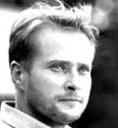Richard Marquis / Glass Artist
Since I’ve decide to make my 3D project work with glass I’ve been looking at many glass artists. Glass art is a quite new media too me and I instantly responded to it because it’s so interesting! It’s not only vase or stained glass, but it’s another material you can use to make sculptures.The first artist I looked at and was very much drawn to is Richard Marquis.He is mad. And cool.Here’s his official site: http://www.richardmarquis.com/The works I really like of his are made with murrine technique.Murrine : Glass formed by sections of various multicoloured glass rods, which are placed so to form a pre-arranged drawing, and then melted together. This technique was already known in Egypt between the third and the first century B.C. It’s now one of the most kown murano glass, used in several different object, from the entry level giftware up to artworks of the best masters. “Millefiori” is often used as common name (with a wrong definition). D’Marquis Teapot Trophies, 1988Blown glass, murrine technique, zanfirico handles
D’Marquis Teapot Trophies, 1988Blown glass, murrine technique, zanfirico handles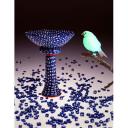 Marquiscarpa, 1999Fused, slumped, blown, and wheel carved glass, murrine techniqueHe seems to be obsessed by murrine.I’ve made a key charm using murrine one at a glass workshop in Japan, which was similar to this.
Marquiscarpa, 1999Fused, slumped, blown, and wheel carved glass, murrine techniqueHe seems to be obsessed by murrine.I’ve made a key charm using murrine one at a glass workshop in Japan, which was similar to this.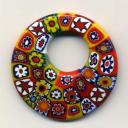 When you place them on top of a glass sheet and heat it you’ll then have them nicely fused as one piece. They’d make a pretty pattern.But Marquis uses them quite differently as you can see. It’s very distinguishable from the way he places murrine. Some look crazy. I love it. It’s like looking at paintings. I could see that he had clear ideas what he was going to make and it was not to make them look pretty.There’s another thing he seems to be very obsessed with. Teapots.He makes tons of teapots with glass.
When you place them on top of a glass sheet and heat it you’ll then have them nicely fused as one piece. They’d make a pretty pattern.But Marquis uses them quite differently as you can see. It’s very distinguishable from the way he places murrine. Some look crazy. I love it. It’s like looking at paintings. I could see that he had clear ideas what he was going to make and it was not to make them look pretty.There’s another thing he seems to be very obsessed with. Teapots.He makes tons of teapots with glass.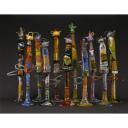
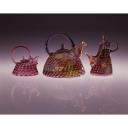

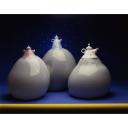 Oh, my God. They’re pretty.And they’re not normal teapots, they’re part of object and they’re object itself. No practical use but I guess he just likes the shape of them.His works have opened my eyes to look at glass art from a new angle. I was taking glass as a far media I would have had used but now I feel that it is just another material I can give it a go to make something.
Oh, my God. They’re pretty.And they’re not normal teapots, they’re part of object and they’re object itself. No practical use but I guess he just likes the shape of them.His works have opened my eyes to look at glass art from a new angle. I was taking glass as a far media I would have had used but now I feel that it is just another material I can give it a go to make something.
2D project
I’ve got no clear ideas what I would do for my 2D project.I thought painting was my favorite medium, but right now it’s giving me some pressure.I did this drawing at home.It’s my grand father and my nephew.My mum used to say that when she went through some life threatening situations she somehow managed not to die, she said that there’s a power from our ancestors which is pulling our life together. We’re protected by something invisible.

Artur Zmijewski
MUST see exhibition of a Polish artist at Collective Gallery.
Artur Zmijewski-Born 1966, Warsaw, Poland
Collective Gallery is featuring 3 months of Scottish/Polish Cultural Stimulation.
Yesterday I was the first one to go into the gallery and sat down to watch Them, a documantary videowork of Artur Zmijewski. You need to watch this from the beginning. It’s worth wating for the film to finish before you actually watch it if the film is alreay started when you go in.
I was quite moved by this video.
I should not talk too much because it would spoil it!
A receptionist also let me watch another short film on TV at their reception area, which was very good as well.
Callum Innes
Born in Edinburgh, 1962.
He’s best known for his Exposed Paintings, and ongoing and complex series in which the canvas is divided geometrically into several areas; some painted, some in which paint has been applied and then dissolved, and some where the ground remains unpainted.
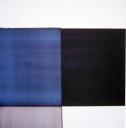
Since 1988 he put efforts devoting himself to non-objective abstraction, creating work that revives and renews the traditions of abstract painting from Kasimir Malevich to Mark Rothko and Robert Rymanresulted. These ‘Exposed Paintings’ came from there.
He applies thick paint on a canvas and uses turpentine to wash away areas. He does this paint-elimination by vertical movements, horizontal movements till the whole area of canvas is exposed. As we could imagine, the word ‘expose’ is a photography term.
Bite the fame
I made this video as my first outcome of Celebrity project.
I was trying to make an illusionary images of something mundane by using video effects.
Popular people I would see on TV, magazines or films are too pretty to me to feel that they’re as same as us.
They look cool, attarctive and good looking.
There is a distinction between being famouse and being popular, I think. And I’m talking about the latter.
People who are popular wouldn’t easily exist without media. The media sends us(public) the images of them then we would like them, or dislike them. But after all, as we see them often on TV or magazines we register them as ‘popular’.
My first idea was to make the video without the effects of mirrors and multiples. I only needed to place the pieces of toast and gave each a bite. Finally I picked one toast and ate it till it disappeared. They looked more or less the same till I started to bite, and the one, which was chosen by me, changed its shape radically toward the end and it no longer existed as toast.
When I was editing I couldn’t resist to use the video effetcs, then I realized that I was making illusionary visuals.
With the effects, toast didn’t look like normal toast anymore. And I thought it was interesting. I felt like that I was producing something else. There’re so many ways that you can present a thing by manipulations. But you could still see that they’re toast. Something we’re all familiar with.
In the reality TV we see ordinary people being pretty famous. It seems to me that the show is so popular that it has a power to make the participants popular.
Personally I don’t watch TV so don’t know the people in those reality TV, but even so I feel like I know them as I come across with them when browsing magazines, newspapers.
Though I don’t mind watching those types of shows I can’t deny a certain stupidity in it.
Switch off TV, stop looking at crappy magazines, then the illusion disappears. But Beethoven and Mother Teresa will stay famouse.

1. Readymade ; Duchamp
Born in 1887, Blainville, France.
He started to paint when he was 15, his first paintings were influenced by impressionism.
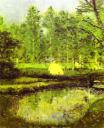
After he went through time at military, Fauve influence, Sunday meetings of artists, and influence of Cezanne, he started imploy black humour in paintings and did Psychological portraits.

From the beginning of 1910s his way of painting shifted from something visual to mental. No longer conventional, he began to reject traditonal subject matter.
We can see that in his ‘Nude Descending a Staircase’ 1912, which was not accepted by his fellow artists who were pursuiting Cubism.

After that he gave up painting.
Duchamp said, ”….painting should noy be only retinal or visual; it should have to do with the gray matter of our understanding instead of being purely visual.”
So, it’s quite understandable that why he started to make works using objects rather than paintings, I think that painting was too visual too him.
His readymade in 1913 was ‘Bicycle Wheel’

There’s a contrast between the chair and the wheel, one is for someone to sit(still) and another is for someone to ride(movement). When they were attached together, they were both useless but it became something else. I could trasnlate it as a representation of the state himself was in at that time. The art world which was surrouding him then was more to do with decipline rather than freedom, or individualism. But his thought was to go beyond, he wanted to be free. But I don’t know if this interpretation is good enough.
He arrived in N.Y. in 1915, he met Man Ray and Picabia. There he was influenced by Dada and Surrealism.
His famous readymade piece was ‘Fountain’, in 1917, which to stir the art world. People asked ”What the xxxx is that?”, ”What is that all about?”
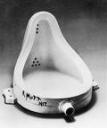
I feel that it was a glimpse of his interests in sexuality. Or it was simply mocking the moneybag collectors who bought arts? I’m not sure. But it was a very simple piece of readymade he made as his works became more complicated later on.
His fundamental concept was ”Neccesity for the engagement of the mind as well as eye.”, which means “Try to look at my works with your mind as well as your eyes.” The visual that his works gives us doesn’t convince us at all. We are required to think, think, think………, and probably, eventually come up with an understanding. But the insight isn’t the same on everyone. Duchamp seemed to enjoy it though. He liked people came up with their own understandings even thought it was far from his concept.
Conceptual Art
Conceptual art does not take a traditional art form. The main medium the conceptual artists use is their concept, ideas. The term conceptual art first came into general use around 1967, but there were artists who did make works which could be recognized as conceptual artworks. They were Duchamp, Man Ray, Picabia, whose works were influenced by Cubism, Dada, Surrealism in 1910s – 1920s.
 Duchamp 1912
Duchamp 1912
 Man Ray 1920
Man Ray 1920
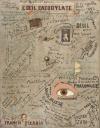 Picabia 1921
Picabia 1921
Conceptual art in general has some forms which could be recognizable ;
1. Readymade objetcs
2. Intervention
3. Documentation
4.Texts/words
*I’ll write about artists later whose works could represent each forms above.
So…, conceptual art then, what is it? It’s maybe easy if we think about what John Cage did with his 4’33” music composition in 1952. He composed the music but its score instructed performers to not to play instruments during the 4 minuets and 33 seconds performance. It would be very very strange to sit there in silence as musicians holding instruments without playing. I used to have a minor panic attack years before and could see myself being very nervous sitting in silence for 4 and half minuets if I were there, I probably would have an urge to run away.
But I know it wasn’t about confining people and make them nervous. It was about letting people to hear the sound of silent. I guess there wasn’t only silent, as with lots of people in a room there should had been someone breathing soundly, coughing, shifting in their seats, sounds from outside world as well. It’s like when we close our eyes we can hear more noise. It wasn’t a visual Cage presented to audiences, it was ‘silence’. But the silence had sounds. It was up to audiences to make the music out of the sounds which they could freely pick up in the silence. Conceptual art has its purpose as exactly as John Cage aimed to achieve. Its task always involves viewers and audiences. The artwork doesn’t complete just because an artist finished making one, it only completes with viewer’s eyes and presence.
Ansel Adams
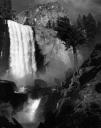


I went to a preview of photography exhibition of Ansel Adams at City Art Centre last night. There’re 150 prints of his famous black and white landscape photography and others. It’s amazing to see how he used traditional printing processes to show such clear images which show meticulous details of tree leaves, snow flakes, grass, water etc. Today we’re too much used to the digital images edited by photoshop, they’re beautiful and skillful. Ansel Adams photos gave me a feeling that I was actually in the photos, the field was in front of me, I felt the ocean breeze. It’s quite rare that I feel that way as I’m not a big fan of landscape photography.I recommend you go there to see the exhibition. You can buy a ticket for £2.50 and go back there again and again with the ticket during the week as there’re so many photos.
Charades me
I was playing around with the video camera hoping to capture usable clips for my Celebrity project for a week.Last night after we had a great pancake party we hopped from a pub to a friend’s flat for a night cap.Nothing special, but it’s funny.
